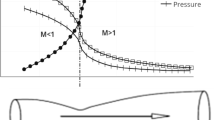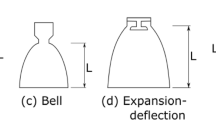Abstract
The use of conjugate circular arcs in rocket nozzle contour design has been investigated by numerically comparing three existing sub-scale nozzles to a range of equivalent arc-based contour designs. Three performance measures were considered when comparing nozzle designs: thrust coefficient, nozzle exit wall pressure, and a transition between flow separation regimes during the engine start-up phase. In each case, an equivalent arc-based contour produced an increase in the thrust coefficient and exit wall pressure of up to 0.4 and 40% respectively, in addition to suppressing the transition between a free and restricted shock separation regime. A general approach to arc-based nozzle contour design has also been presented to outline a rapid and repeatable process for generating sub-scale arc-based contours with an exit Mach number of 3.8–5.4 and a length between 60 and 100% of a 15\(^{\circ }\) conical nozzle. The findings suggest that conjugate circular arcs may represent a viable approach for producing sub-scale rocket nozzle contours, and that a further investigation is warranted between arc-based and existing full-scale rocket nozzles.
















Similar content being viewed by others
References
Vuillermoz, P., Weiland, C., Hagemann, G., Aupoix, B., Grosdemange, H., Bigert, M.: Nozzle design and optimization. In: Yang, V., Habiballah, M., Hulka, J., Popp, M. (eds.) Progress in Astronautics and Aeronautics: Liquid Rocket Thrust Chambers, pp. 469–492. American Institute of Aeronautics and Astronautics, Reston (2004). https://doi.org/10.2514/5.9781600866760.0469.0492
Shapiro, A.: Nozzles for supersonic flow without shock fronts. J. Appl. Mech. 11(2), 93–100 (1944)
Ahlberg, J., Hamilton, S., Migdal, D., Nilson, E.: Truncated perfect nozzles in an optimum nozzle design. ARS J. 31(5), 614–620 (1961). https://doi.org/10.2514/8.5577
Gogish, L.: A study of short supersonic nozzles. Fluid Dyn. 1(2), 122–126 (1966). https://doi.org/10.1007/bf01013838
Watanabe, Y., Sakazume, N., Yonezawa, K., Tsujimoto, Y.: LE7A engine nozzle flow separation phenomena and a method of RSS suppression with a step inside nozzle. J. Jpn. Soc. Aeronaut. Space Sci. 55(645), 474–482 (2007). https://doi.org/10.2322/jjsass.55.474
Guderley, G., Hantsch, E.: Beste Formen fur Aschsensymmetrische Uberschallschubdusen. Zeitschrift fur Flugwissenschaften 3, 305–313 (1955)
Rao, G.: Exhaust nozzle contour for optimum thrust. Jet Propuls. 28(6), 377–382 (1958). https://doi.org/10.2514/8.7324
Rao, G.: Approximation of optimum thrust nozzle contour. ARS J. 30(6), 561 (1960)
Nave, L., Coffey, G.: Sea level side loads in high-area-ratio rocket engines. In: 9th AIAA Joint Propulsion Conference, AIAA Paper 73-1284 (1973). https://doi.org/10.2514/6.1973-1284
Sutton, G.: History of Liquid Propellant Rocket Engines, pp. 91–92. American Institute of Aeronautics and Astronautics, Reston (2006). https://doi.org/10.2514/4.868870
Sternin, L.: Analysis of the thrust characteristics of jet nozzles designed by various methods. Fluid Dyn. 35(1), 123–131 (2000). https://doi.org/10.1007/bf02698797
Davis, D.: Investigation of optimization techniques for solid rocket motor nozzle contours. In: 18th AIAA Joint Propulsion Conference, AIAA Paper 82-1188 (1982). https://doi.org/10.2514/6.1982-1188
Sutton, G., Biblarz, O.: Rocket Propulsion Elements, pp. 27–102. Wiley, Hoboken (2010)
Schomberg, K., Doig, G., Olsen, J.: Design of high area nozzle contours using circular arcs. J. Propul. Power 32(1), 188–195 (2016). https://doi.org/10.2514/1.b35640
Schomberg, K., Olsen, J., Neely, A., Doig, G.: Suppressing restricted shock separation in thrust-optimized rocket nozzles using contour geometry. J. Propul. Power 32(5), 1298–1301 (2016). https://doi.org/10.2514/1.b36059
Stark, R., Hagemann, G.: Current status of flow prediction for separated nozzle flows. In: 2nd European Conference for Aerospace Sciences, pp. 1–8 (2007)
Ostlund, J.: Flow Processes in Rocket Engine Nozzles with Focus on Flow Separation and Side-Loads. Royal Institute of Technology, Stockholm (2002)
Nguyen, A., Deniau, H., Girard, S., Alziary De Roquefort, T.: Unsteadiness of flow separation and end-effects regime in a thrust-optimized contour rocket nozzle. Flow Turbul. Combust. 75, 161–181 (2003). https://doi.org/10.1023/b:appl.0000014927.61427.ad
Spalart, P., Allmaras, S.: A one-equation turbulence model for aerodynamic flows. La Recherche Aerospatiale 1(5), 5–21 (1992)
Sutherland, W.: The viscosity of gases and molecular force. Philos. Mag. 36, 507–531 (1893). https://doi.org/10.1080/14786449308620508
Roache, P.J.: Quantification of uncertainty in computational fluid dynamics. Annu. Rev. Fluid Mech. 29, 123–160 (1997). https://doi.org/10.1146/annurev.fluid.29.1.123
Meijer, J., Van Beek, C.: Analysis of Ariane 5 Base Flow Measurements in the NLR/PHST and FFA/T1500 Wind Tunnels, NLR-CR 99449, National Aerospace Laboratory (1999)
Wang, T., Guidos, M.: Transient three-dimensional side-load analysis of a film-cooled nozzle. J. Propul. Power 25(6), 1272–1280 (2009). https://doi.org/10.2514/1.41025
Software Engineering Associates (SEA) Inc., Two-Dimensional Kinetics (TDK) Nozzle Performance Computer Program Users Manual, pp. 4–19 (2007)
Schomberg, K., Olsen, J., Neely, A., Doig, G.: Design of an arc-based thrust-optimized nozzle contour. In: 6th European Conference for Aerospace Sciences, pp. 1–8 (2015)
Author information
Authors and Affiliations
Corresponding author
Additional information
Communicated by H. Olivier and A. Higgins.
Publisher's Note
Springer Nature remains neutral with regard to jurisdictional claims in published maps and institutional affiliations.
Rights and permissions
About this article
Cite this article
Schomberg, K., Olsen, J., Neely, A. et al. Investigation of conjugate circular arcs in rocket nozzle contour design. Shock Waves 29, 401–413 (2019). https://doi.org/10.1007/s00193-018-0834-0
Received:
Revised:
Accepted:
Published:
Issue Date:
DOI: https://doi.org/10.1007/s00193-018-0834-0




